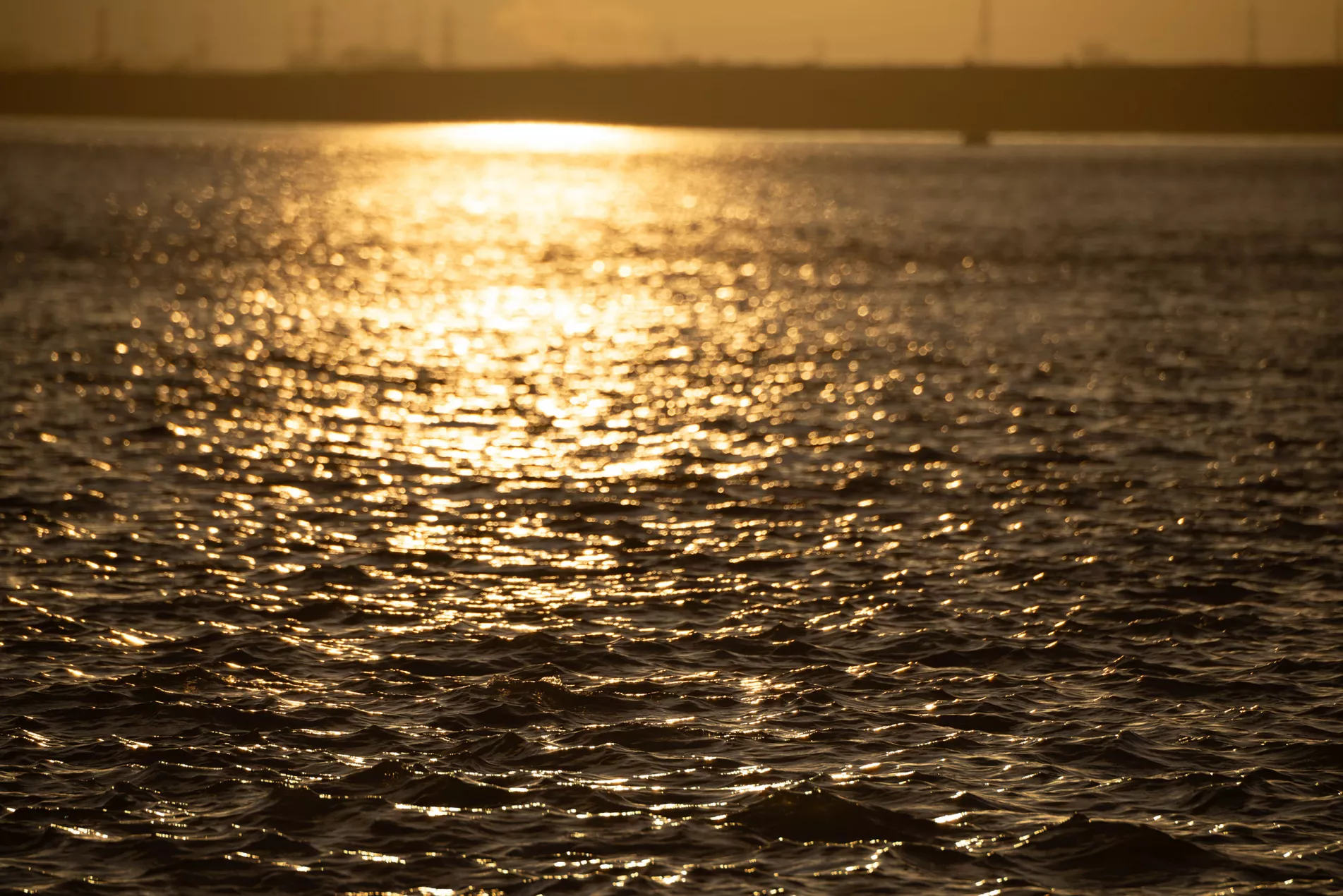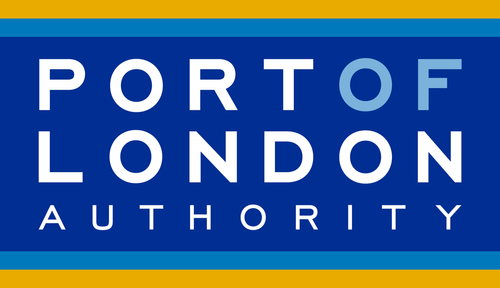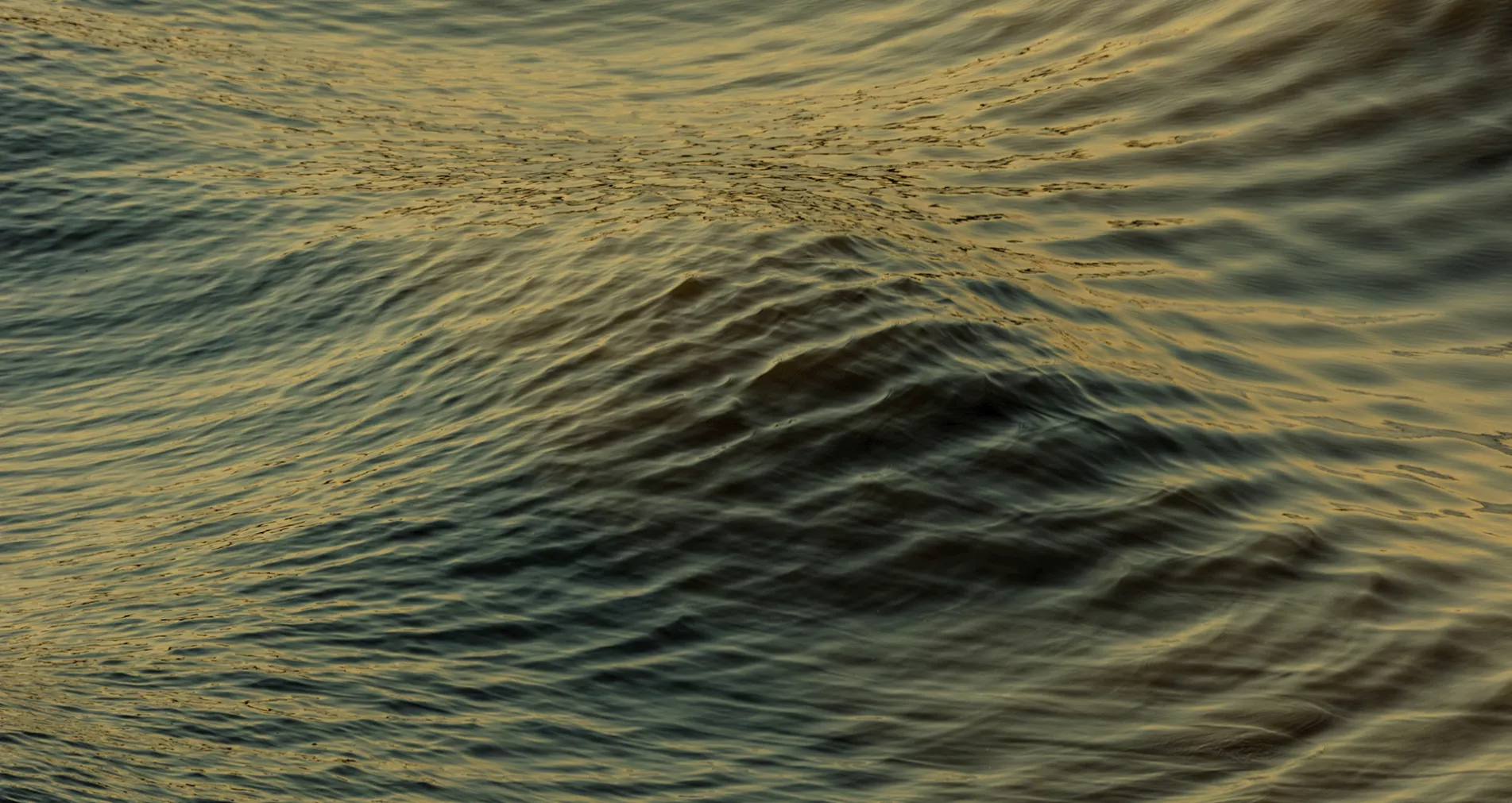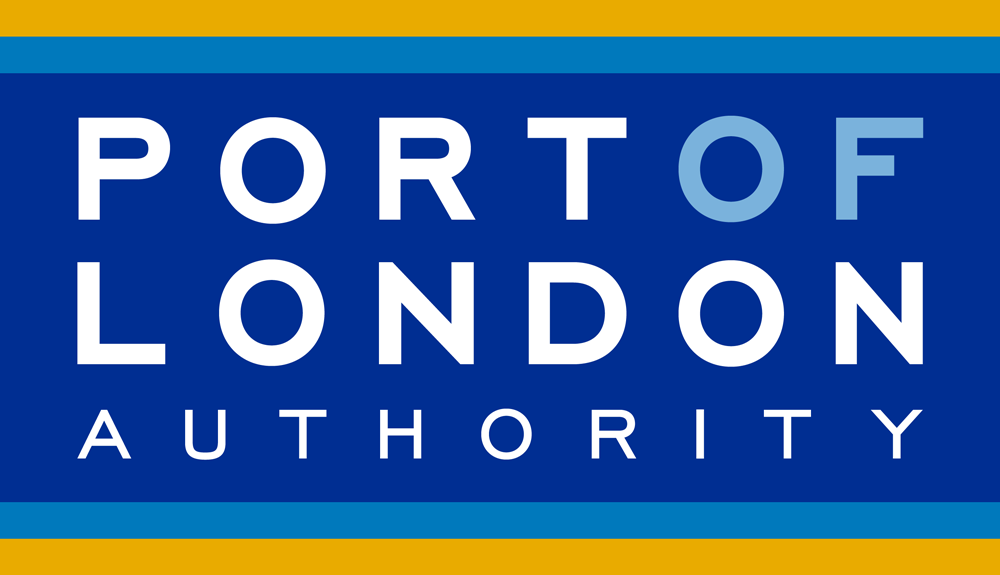Live Tides
NOTICES TO MARINERS
Charts & Surveys
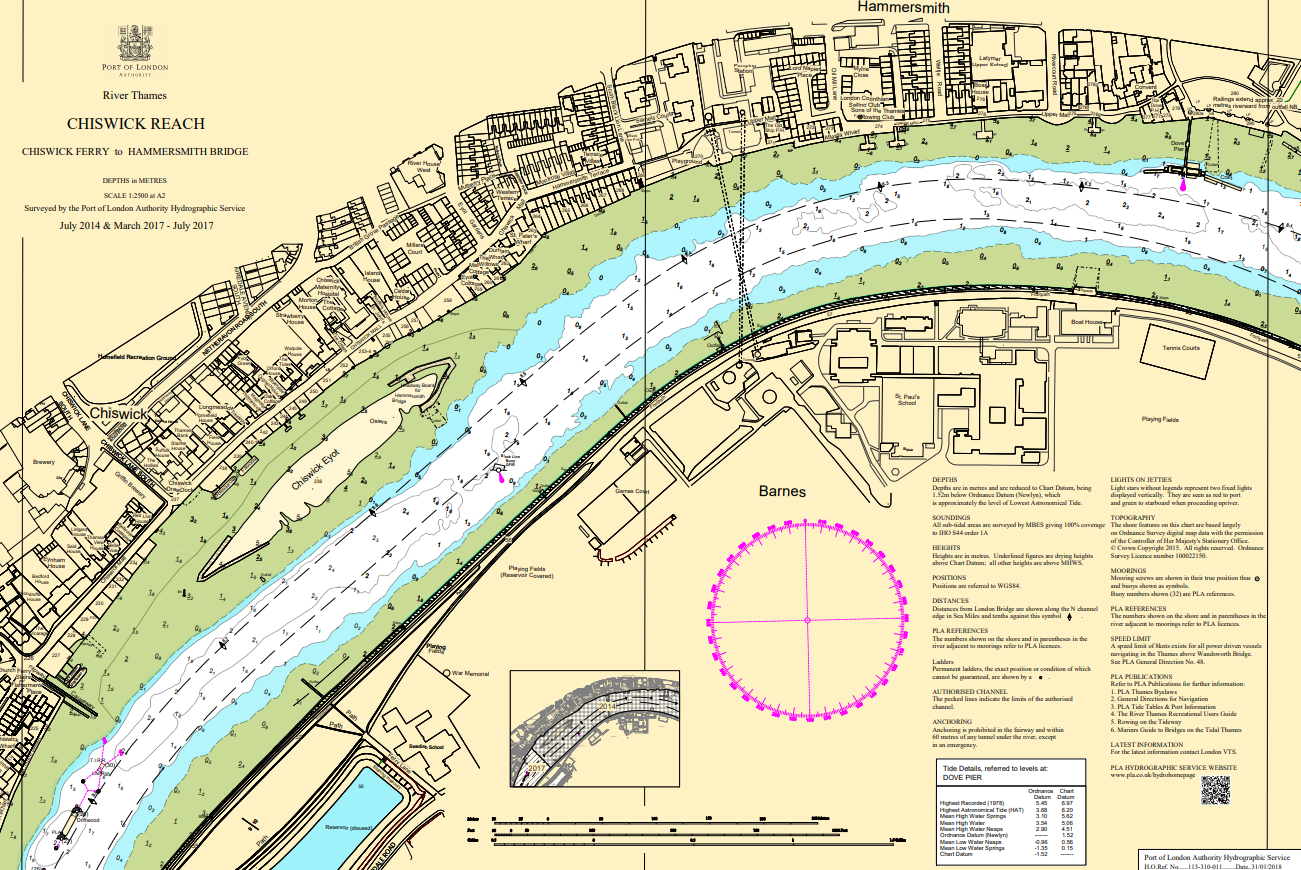
Incident reporting
Life-threatening emergencies on the river:
Call 999 and ask for the Coastguard
For near miss, safety observations and incident reporting click below
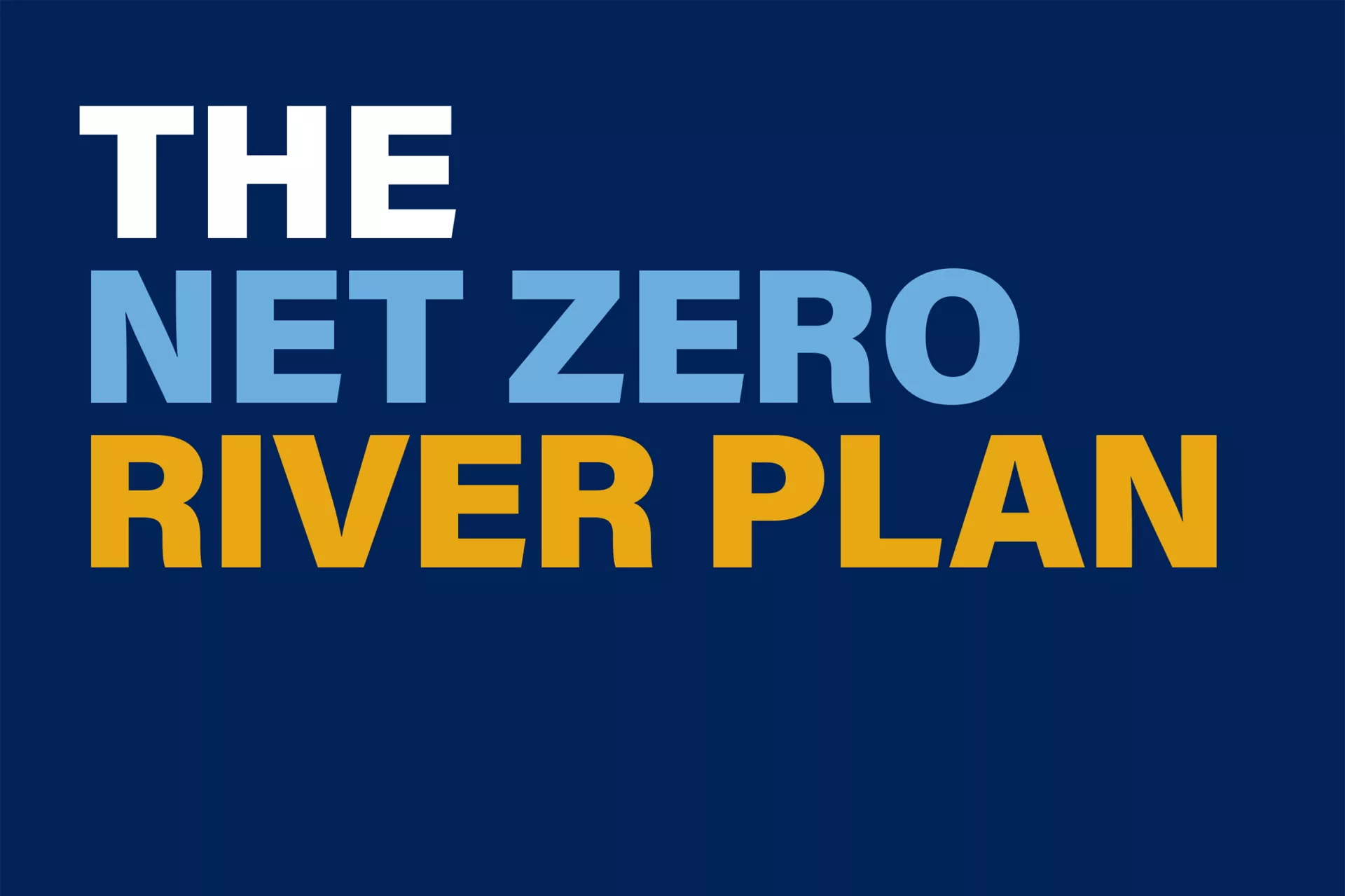
MESSAGE FROM THE CHIEF EXECUTIVE
The Port of London Authority’s (PLA) purpose is to improve and protect the tidal Thames for all. Our mission is to create a thriving river, home to the UK’s number one port.
Ports underpin the global economy and play an essential role in our everyday lives. More than 80% of global merchandise trade is transported via sea. Similarly, inland waterways, such as the Thames, are a vital lifeline for the movement of cargo and materials. Nearly three million tonnes’ of inland cargo, waste and construction materials are transported on the river annually – taking 140k lorry loads off the roads.
While shipping remains the most carbon efficient mode of international transport for freight, it accounts for approximately 3% of global greenhouse gas emissions.
The UK maritime sector must reach Net Zero by 2050 - this requires collaboration on an unprecedented scale. Bold action across the sector before 2030 is needed to meet international targets and keep pace with competitors as supply chain logistics decarbonise.
At the Port of London Authority (PLA), we can demonstrate leadership through our role as the port authority for the UK’s most iconic river, home to the UK’s number one port, to tackle some of these key challenges. In our Thames Vision 2050, developed with partners and stakeholders along the river, we set an ambitious goal of reaching Net Zero by 2040 – and we have already halved our emissions from our baseline year. We are also measuring emissions from vessel movements in our jurisdiction to identify strategic opportunities to support vessels to decarbonise faster.
But we cannot do this alone. We need to work with terminals and vessel operators to achieve Net Zero for the river - putting the building blocks in place to drive action beyond our areas of responsibility.
There are countless examples of the river community taking steps to reduce carbon emissions. In the last year alone, we have seen hybrid passenger vessels, fully electric workboats, and methanol-ready container ships in the port. More and more operators are showing climate leadership by switching to lower carbon fuels, despite the additional costs they incur.
In 2023, we convened the Thames Net Zero Coalition, to bring together river operators and share challenges and deepen collaboration – and shape our Net Zero River Plan. The plan focuses on river-based emissions – primarily from vessel movements. While the PLA is not directly responsible for these emissions, we know this is a crucial first step to wider emissions reductions and gaining a competitive advantage for river operators.
The Net Zero River Plan aims to do three things. Firstly, the plan brings together the concerns, challenges and opportunities that coalition members face in decarbonising. Secondly, we aim to tell the story of the considerable progress achieved so far. And finally, the plan identifies the actions that the PLA will take in the next three years to support decarbonisation of river-based emissions.
We know that this speed of change in sustainability causes uncertainty and risks for the operators on the Thames. The
Net Zero River Plan and ongoing work of the coalition will put Thames operators at a commercial advantage, ensuring that the Port of London, and the river community, stays competitive and sustainable for the future.
Robin Mortimer, Chief Executive, Port of London Authority
OUR NET ZERO RIVER PLAN
As part of the PLA’s Thames Vision 2050, we made a commitment to convene a Thames Net Zero Coalition to produce an action plan to reduce emissions on the Thames.
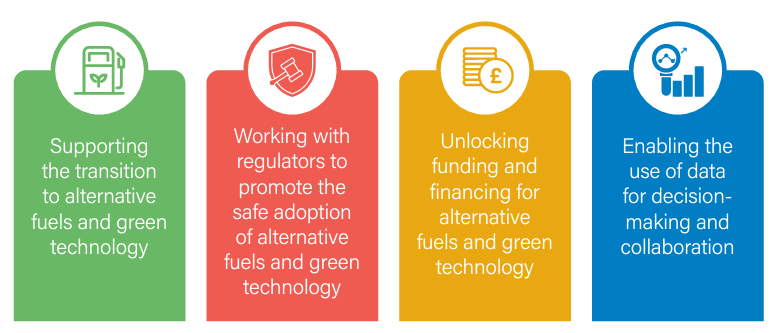
The Coalition is made up of terminal and vessel operators and supporting stakeholders. In 2023, we launched the Net Zero Coalition with a series of workshops designed to understand the challenges and opportunities for decarbonisation on the river.
The work of the Coalition helped the PLA to identify four priority themes to help accelerate the transition to Net Zero on the Thames; 1) alternative fuels and infrastructure adoption, 2) clear regulation and legislation, 3) funding and 4) robust data. These themes have shaped our four commitments to support a Net Zero River.
We have already supported decarbonisation on the river through a variety of initiatives and programmes. This Net Zero River Plan (2024-27) builds on those efforts and formalises our approach for the next three years. We commit to updating this plan on a three-year cycle, recognising the pace of innovation and change required to meet the UK’s targets. We will continue to work with the Net Zero Coalition to keep this plan relevant and useful to their individual and collective efforts.
THE NET ZERO COALITION
ABOUT THE PORT OF LONDON AUTHORITY
We offer our sincere thanks to the following organisations who have helped to shape our Net Zero River Plan:
• Boluda Towage
• Britannia Aggregates
• Cemex
• Cory
• Cross River Partnership
• Day Group
• Department for Transport
• Ford Dagenham
• GPS Marine
• Livetts
• London & Partners
• London Gateway, DP World
• Maritime and Coastguard Agency
• Net Zero Marine Services
• Oikos
• Port of Tilbury, Forth Ports
• Stema Shipping
• Thames Estuary Growth Board
• Thames Freeport
• Thames Luxury Charters
• Thames Marine Services
• Uber Boat by Thames Clippers
• Woods Silver Fleet
The Port of London Authority (PLA) is the owner in trust of the riverbed and foreshore of the tidal Thames from Teddington Lock to the Estuary. The purpose of the PLA is to improve and protect the tidal Thames for all. We ensure the safe navigation of the river, enable trade and recreation, and protect the health of the river’s ecosystems. Our Thames Vision 2050 sets out our goal of being the UK’s largest port, central to the economy, with Net Zero emissions.
The Port of London is made up of 70 independently owned terminal operations and hundreds of vessel operators who provide services to those terminals and across the river. It is also the busiest inland waterway in the UK for freight and passengers.
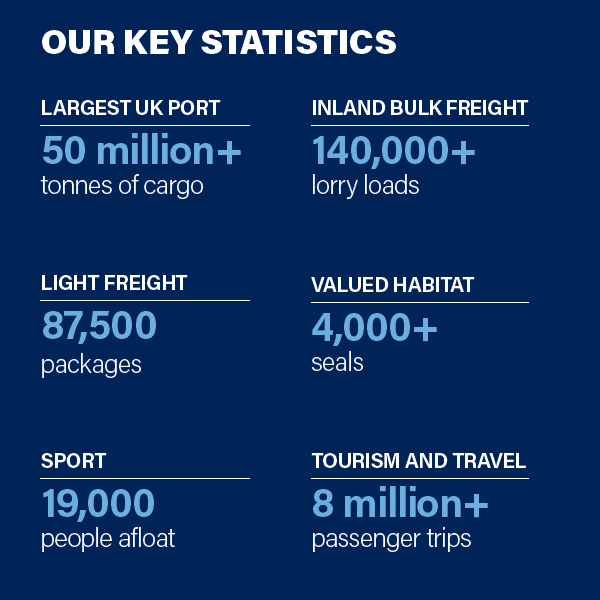
OUR AMBITION: NET ZERO RIVER
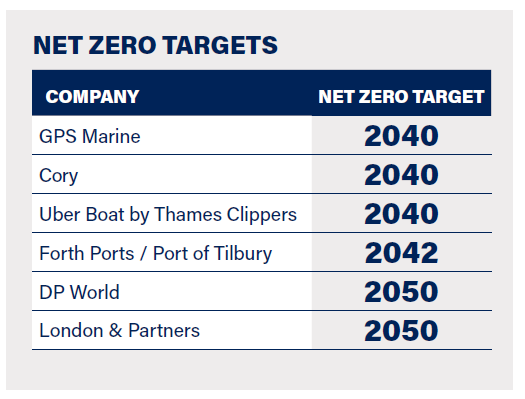 Operators along the Thames have set different targets for achieving Net Zero based on their own operational realities. This is driven by their land-side emissions, river-based emissions (primarily vessel activities) and wider Scope 3 considerations.
Operators along the Thames have set different targets for achieving Net Zero based on their own operational realities. This is driven by their land-side emissions, river-based emissions (primarily vessel activities) and wider Scope 3 considerations.
The PLA are committed to pushing for faster decarbonisation of river-based emission sources – primarily from vessel movements.
While the PLA is not directly responsible for these emissions, we know that reducing them is a crucial step in creating a Net Zero river.
We want to work with operators along the river community to achieve Net Zero for river emissions by sooner than government targets. That is because we know that the future of trade and transportation on the river requires swift action to be on track to meet the UK and international targets for 2050.
And we know that this is the decade to act. At least 5% of global shipping will need to use zero-emissions fuel by 2030 to achieve this.
As pressure from consumers, governments and customers increases, the need to demonstrate progress towards decarbonisation will intensify across the maritime sectors. Achieving Net Zero, in river-based emissions sources, will put the Thames and London at a competitive advantage – securing our future as a green destination for trade and leisure.
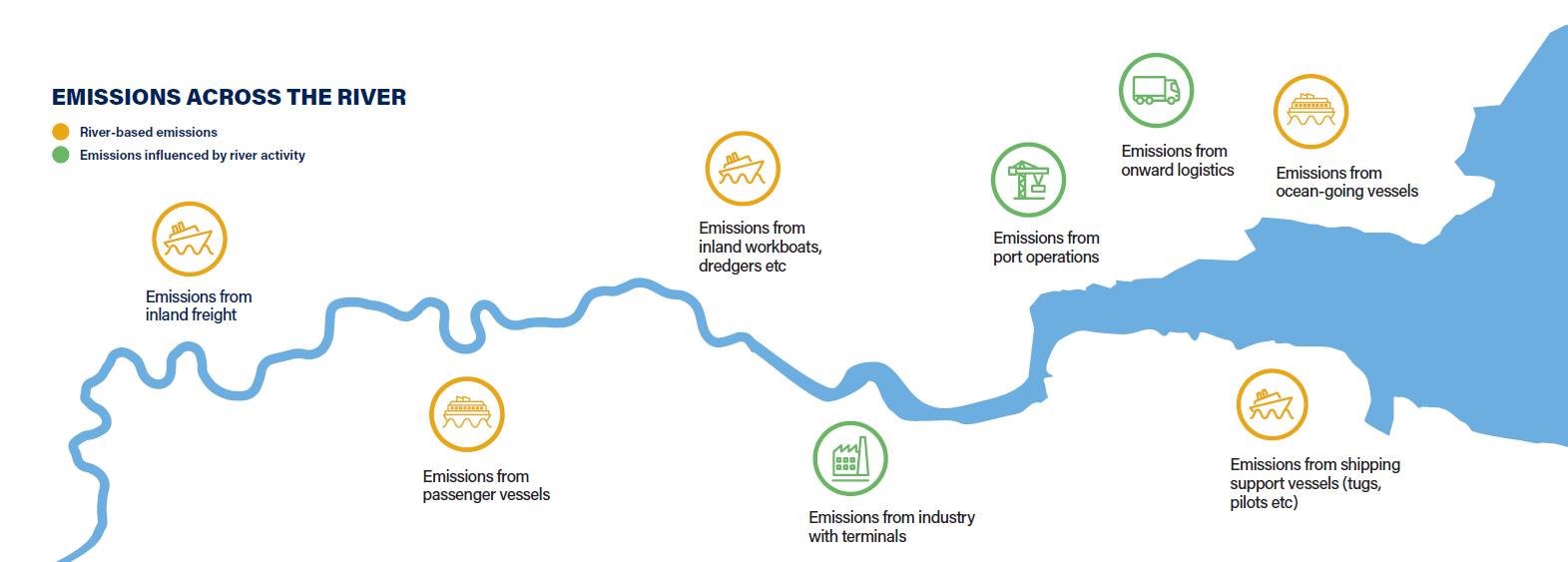
PROGRESS ON NET ZERO
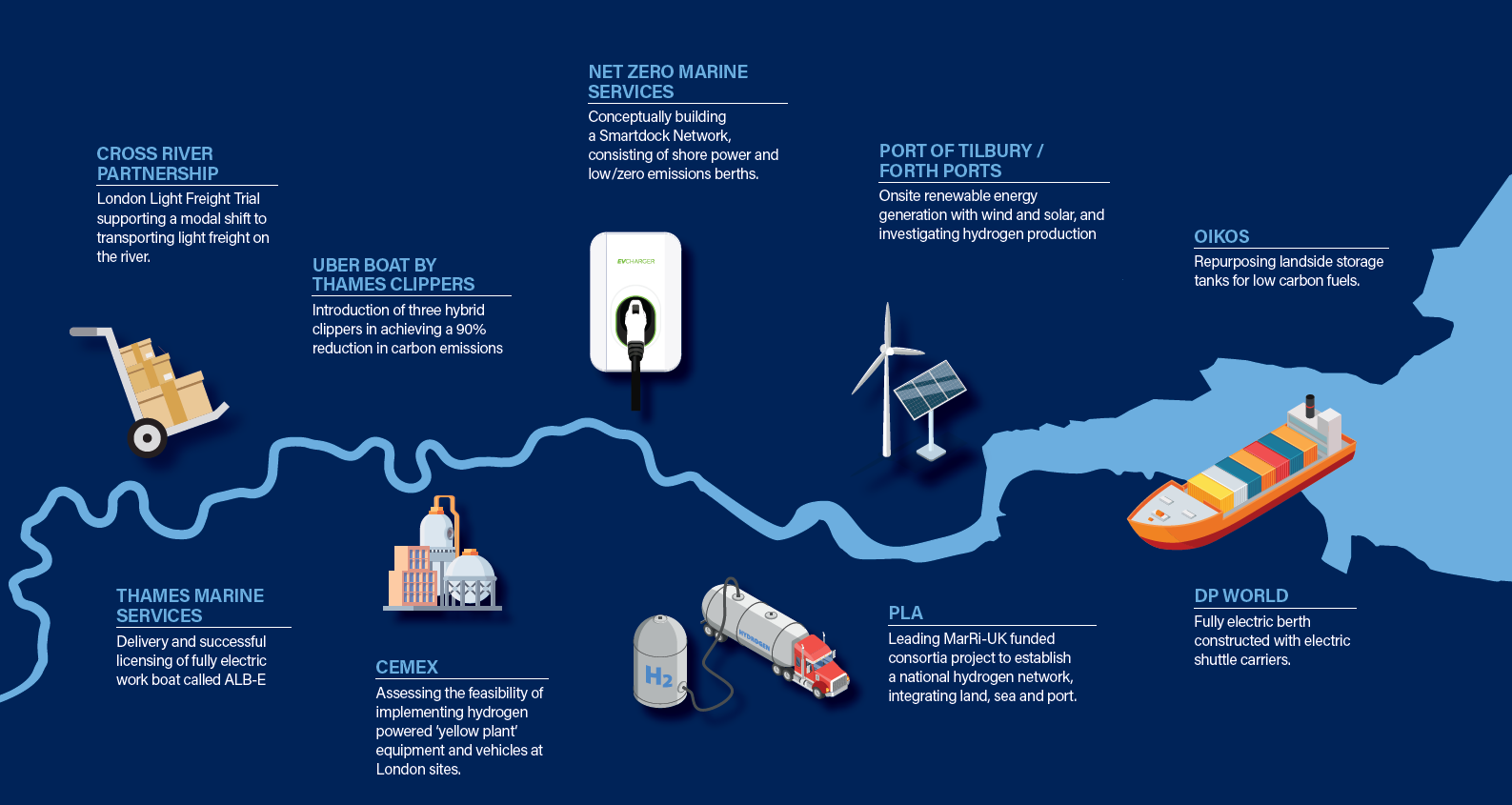 This map represents projects that are currently in progress as of 2023 across the Thames that support decarbonisation. This is not an exhaustive list of projects but represents some exemplars from Thames operators.
This map represents projects that are currently in progress as of 2023 across the Thames that support decarbonisation. This is not an exhaustive list of projects but represents some exemplars from Thames operators.
OUR ACTIONS: NET ZERO RIVER
Supporting the transition to alternative fuels and green technology
"We are very pleased to be part of the Port of London Authority’s Net Zero Coalition and to support its essential sustainability ambitions. At DP World, we are working hard to become a net-zero logistics organisation by 2050 and are currently delivering several major initiatives at London Gateway, such as its £350m new fourth berth, which will be the world’s first all-electric berth on opening in 2024." -- DP World Spokesperson
Decarbonising the river will require the large-scale adoption of alternative low-carbon fuels. With many different alternatives and no ‘one size fits all’ solution, ports are increasingly having to consider how they will adapt to a mix of fuels in the future. Among the challenges to the sector are concerns about risks involved in transitioning to new fuels and technologies. This includes the future direction of regulation, end customer support and willingness to pay, demand from other sectors and competition risks to early adopters.
Additionally, the transition to lower carbon fuels and green technologies on the Thames will require the right infrastructure to support it. This could take the form of shore power and charging stations, alternative fuel bunkering and storage, and the production, import and export of alternative fuels. Investing in infrastructure can be costly and with uncertainty around the demand and supply of green fuels, it is difficult for operators to make long term commercial decisions.
To support the Thames operators to transition to alternative fuels and greener technology, we commit to undertaking the following enabling actions:
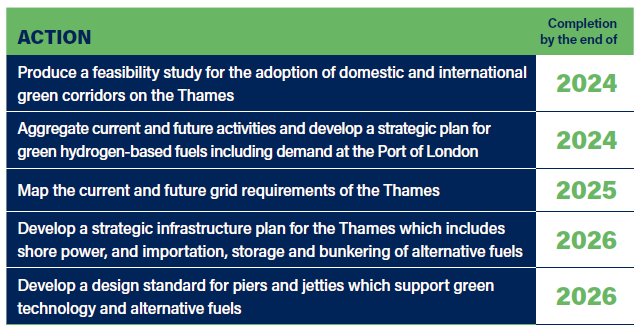
Alternative fuel types
Methanol – can be used directly in an internal combustion engine or fuel cell. Can be used as a fuel itself or a store for hydrogen.
Hydrogen – can be used as an input to ammonia or methanol production as well as a fuel itself.
Ammonia - can either be used as a fuel itself, or as a carrier for hydrogen before the hydrogen is used as the fuel.
Biofuels – Used directly in an internal combustion engine. Various types of biofuels from different sources of biomass (e.g. crops, wastes) possible.
Hybrid propulsion – a diesel engine acts as a power source, charging batteries which power an electric motor, often in order to keep the diesel operating at its most efficient load point. Fully electric propulsion - no diesel engine. An electric motor is entirely powered by batteries, which are charged whilst the vessel is in port.
Source (Clean Maritime Plan 2019)
OUR ACTIONS: NET ZERO RIVER
Working with regulators to promote the safe adoption of alternative fuels and green technology
"Clear and consistent policy direction is needed to support the economic feasibility at scale for green fuels"
Clear and consistent policy direction is needed to support the economic feasibility at scale for green fuels, as well as build confidence to stimulate investment in fuels, vessels and supporting infrastructure. Similarly, the regulatory environment needs to keep pace with the speed of innovation required to meet the UK’s Net Zero ambitions.
A clear and streamlined regulatory environment is required to support the early and safe adoption of green technologies – allowing operators making greener choices to gain a competitive advantage. This is particularly important as many Thames operators face decisions about transitioning their fleets of vessels over the next ten years. Capitalising on this opportunity is essential due to the lifespan of commercial vessels.
To support the Thames operators to transition to alternative fuels and greener technology, we commit to undertaking the following enabling actions:
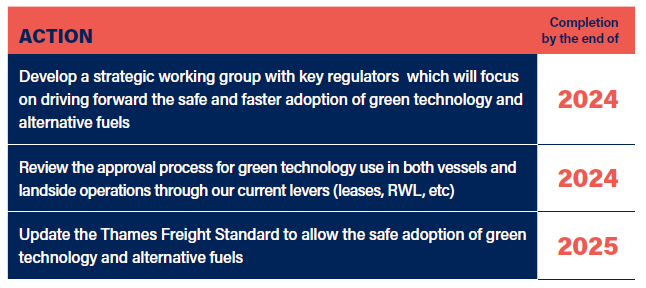
Key regulators and organisations
International Maritime Organisation (IMO)– is the United Nations specialised agency with responsibility for the safety and security of shipping and the prevention of marine and atmospheric pollution by ships.
Maritime and Coastguard Agency (MCA) is an executive agency sponsored by the Department for Transport which works to prevent the loss of life on the coast and at sea. The MCA produces legislation and guidance on maritime matters and provides certification to seafarers.
Port of London Authority (PLA) is the harbour authority for the tidal Thames and certifies vessels through the Thames Freight Standard, where those vessels are not under the certification of the MCA
OUR ACTIONS: NET ZERO RIVER
Unlocking funding and financing for alternative fuels and green technology
"The Port of Tilbury is proud to play its part in the Thames Net Zero Coalition, collaborating with customers and partners across the estuary to enable and accelerate the transition to Net Zero. As part of the Forth Ports Group, the Port of Tilbury is committed to being carbon neutral by 2032 and net zero by 2042. These ambitious commitments, together with investments to promote modal shift and alternative fuels, underscore our vision for delivering low carbon logistics solutions across London and the South East.” Forth Ports Spokesperson
Transitionary, lower-carbon fuels are becoming more competitive but rarely reach parity with traditional fuel types. Companies that are switching to lower carbon fuels are doing so at a cost. Funding and financing of decarbonisation strategies and projects was cited as a major obstacle facing operators on their journeys to Net Zero.
Clean Maritime Decarbonisation Competition (CMDC) and Zero Emission Vessel and Infrastructure (ZEVI) funding from UK Shore over recent years has helped support the innovation of new technologies for the sector. We are now starting to see vessels that can operate with lower emissions – such as electric workboats, hybrid passenger vessels, and the uptake of biodiesels. However, the roll out of these technologies is dependent upon availability and affordability. As these technologies mature, government funding to support wider spread scaling across the sector will be required to stimulate adoption.
To support the Thames operators to transition to alternative fuels and greener technology, we commit to undertaking the following enabling actions:

Key government policies:
• In July 2021, the government published the transport decarbonisation plan which contains a commitment to refresh the clean maritime plan and establish ambitious ‘course to zero’ of indicative targets for the domestic maritime sector.
• The Alternative Fuels Infrastructure Regulations 2017 is the underpinning legislation which ensures the way electricity and hydrogen are supplied to vehicles or ships is consistent across the UK. This will reduce dependence on oil and the environmental impact of transport, while contributing to a low carbon economy.
• Related strategies include the UK hydrogen strategy (2021) which
sets out the approach to developing a thriving low carbon hydrogen sector in the UK; and UK biomass strategy (2023) which sets out the role sustainable biomass can play in reaching Net Zero.
OUR ACTIONS: NET ZERO RIVER
"A collaborative approach is absolutely imperative to ensure that the port, stakeholders and operators fully understand the needs and future infrastructure requirements to support the future supply chains and day to day requirements in order to achieve our route to net zero.” Sean Collins, Uber Boat by Thames Clippers
Good quality and robust data is key to evidence-based decision making and gaining a competitive advantage. However, many of the operators on the Thames are small, agile businesses who do not have resources to invest in data collection and analysis.
Providing access to data on the Thames will allow operators to provide robust evidence on funding bids, commercial opportunities and partnership work.
Building and using this evidence base will strengthen the ability of the Thames to effectively transition to Net Zero.
To support the Thames operators to make evidence-based decisions, we commit to undertaking the following enabling actions:

Clean, green growth in the Thames Estuary means a Net Zero river and we’re delighted to be working with the PLA to deliver it.
Electric and hydrogen-powered ferries and new, clean, green opportunities for freight will transport people to places and goods to market cutting carbon, building business and connecting communities.
With innovative new approaches to green investment in the Thames Estuary together we can make this happen.
Kate Willard, Thames Estuary Envoy and Chair of the Thames Estuary Growth Board
Supporting research
Navigational safety policy
We have the primary responsibility for maintaining safe access and managing the safety of vessels, the general public and all users of the tidal River Thames
Through the Port of London Act 1968 (as amended), the Port of London Authority (PLA) has the primary responsibility of maintaining safe access and managing and supporting the safety of navigation for all river users on the Tidal Thames.
Additionally, the PLA is committed to complying fully with the standards laid down in the Port Marine Facilities Safety Code (PMSC) and the management of navigation shall be in accordance with those standards. The Board of the PLA, as the Duty Holder, are collectively and individually accountable for the management of marine safety under the Code.
To this end, navigational safety will be managed according to the following objectives:
- Safety Management System - Maintain an effective marine Safety Management System (SMS) and Regulatory Framework, which meets the requirements of the PMSC and the Port’s legal responsibilities, based on formal assessment and mitigation of risk, ensuring this is monitored,
reviewed and audited. Publish a Marine Safety Plan every 3 years and report performance against the plan annually. - Pilotage - Ensure that the operation of the Pilotage Service and PEC system is compliant with the Pilotage Act 1987, national regulations, guidelines and competency standards to provide a safe, effective and efficient pilotage service
- Vessel Traffic Service - Operate the London Vessel Traffic Service (VTS) to IMO, IALA and national standards to manage the safety and efficiency of navigation.
- Hydrography - Undertake such hydrographic surveys as are necessary for safe and efficient navigation within port limits through a managed survey programme of the bed of the Thames and to provide this information to river users.
- Vessel Licensing - Verify the fitness for purpose of all PLA licensed inland waterways commercial vessels by inspection, ensure effective supporting operational safety management systems and where appropriate, define and enforce minimum crew competencies.
- Management of River Activities and Works - Ensure, through an appropriate level of risk assessment that the approval of river activities and river works takes due regard of the safety of navigation.
- Emergency Preparedness and Response - Ensure that appropriately detailed emergency plans are prepared in conjunction with other relevant authorities, and that such plans are published and periodically exercised. Appropriate training to be provided where required.
- Incident Investigation and Enforcement - Develop and maintain effective investigation and enforcement procedures that comply with national requirements and best practice, identifying, promulgating and making good use of any ‘lessons identified’. Effectively promulgate, apply and enforce byelaws, directions and procedures, responding to breaches or criminal offences, and where necessary initiating a prosecution, whilst observing the Code for Crown Prosecutors.
- Consultation - Consult as early as is practicable, and encourage comment and contribution from, users, stakeholders and beneficiaries, for assessment of risk, when changes to PLA legislation, policy and navigational markings are being considered, and to publish the feedback.
- Marine Training - Ensure that all marine personnel are competent to perform the duties allocated to them through the adoption of the levels of knowledge and skill associated with relevant international, national and local standards and that revalidation and maintenance of qualifications is undertaken.
- Environment - Comply with the PLA’s responsibilities to the natural, human and built environment and ensure procedures and measures are in place to minimise environmental impacts arising from its activities in line with the PLA’s Environmental Policy.
This policy was approved by the PLA Executive Committee in January 2024.
Port of London Authority and partners launch Net Zero River Plan for the Thames
Working together to accelerate progress towards decarbonising the Thames, the Port of London Authority (PLA) and a coalition of terminal and vessel operators and supporting stakeholders, have today published a plan for a Net Zero future

Headlines
- Has wide support across the Thames community
- Plan will accelerate the move to Net Zero for the Thames Estuary region
- Unlocks funding and financing for alternative fuels
The Net Zero River Plan identifies four priority themes to accelerate the move to Net Zero: alternative fuels and infrastructure adoption; clear regulation and legislation, funding, and reliable data.
These themes inform four robust commitments and a clear plan of action to support Thames operators transitioning towards and adopting sustainable alternative fuels and green technology:
- Supporting the transition to alternative fuels and green technology, including through a strategic infrastructure plan for the Thames for shore power, and the importation, storage and bunkering of alternative fuels.
- Working with regulators to promote the safe adoption of alternative fuels and green technology, with a 2024 review of the approval process for green technology use.
- Unlocking funding and financing for alternative fuels and green technology, which will include a “Centre of Excellence for Green Projects” for Thames operators to capitalise on future government funding cycles.
Enabling the use of data for decision-making and collaboration, with access provided to the Maritime Emission Portal data for operators on the Thames. - Significant progress is already being made towards Net Zero, with onsite renewable energy generation at terminals, use of the river for light freight deliveries, construction of fully electric berths, the introduction of hybrid passenger vessels, and a fully electric work boat delivered and licensed for use.
Grace Rawnsley, Director of Sustainability at the Port of London Authority, said: “We’re working with operators from the length of the tidal Thames as we know that taking rapid action to reduce emissions is vital both to addressing climate change and to ensure a competitive future for trade and transportation. All of the terminal and vessel operators involved, as well as other supporting stakeholders, are showing great commitment to Net Zero and a sustainable future for our river.”
Olly Brown, Development Director at Brett Group, said: “We are proud to be a coalition partner with the PLA and support their vision towards Net Zero. As a business we’ve been investing in developing wharves along the Thames for over 20 years - to deliver building materials in a more sustainable way into the heart of London."
Laurence Dagley, Business Development Director at Cemex, said: “Close collaboration between industry, port operators and government is essential if we are to collectively deliver upon our Net Zero commitments, in particular to deliver a regulatory framework that supports innovation and investment. We applaud the PLA for their leadership and look forward to working with the coalition in delivering this ambitious but necessary plan for the Thames.”
Susannah Wilks, Cross River Partnership Director, said: “Cross River Partnership is committed to continuing to facilitate productive partnerships between river and land-based agencies that enable a scaling up of clean river freight into central London, with zero emission e-cargo bikes for onward deliveries.”
Kate Willard, Thames Estuary Envoy and Chair of the Thames Estuary Growth Board, said: “Clean, green growth in the Thames Estuary means a Net Zero river and we’re delighted to be working with the PLA to deliver it. Electric and hydrogen-powered ferries and new, clean, green opportunities for freight will transport people to places and goods to market cutting carbon, building business and connecting communities. With innovative new approaches to green investment in the Thames Estuary together we can make this happen.”
Miles Cole, Managing Director of Net Zero Marine, said: “Net Zero Marine Services (NZMS) is delighted to be part of the Net Zero coalition and support the PLA’s Thames Vision 2050. At NZMS we are developing shore power stations that will future proof clean and sustainable marine transport on the Thames Estuary.”
Martin Whiteley, Chief Executive Officer for Thames Freeport, said: "The Thames Freeport is committed to delivering sustainable growth on the Thames, unleashing London's greatest opportunity in a generation to decarbonise and grow industries in the region. We welcome and support the ambitions of the Port of London Authority and partners of the Net Zero Coalition which will position the River Thames at the heart of the net zero transition, enabling sustainable supply chains, generating new, green job opportunities for future generations, reducing the environmental impact of transport on communities and bringing innovative industries to our region."
Related content

Location: London/Gravesend Remuneration: £28,971 per annum for a commitment of up to 24 days per...
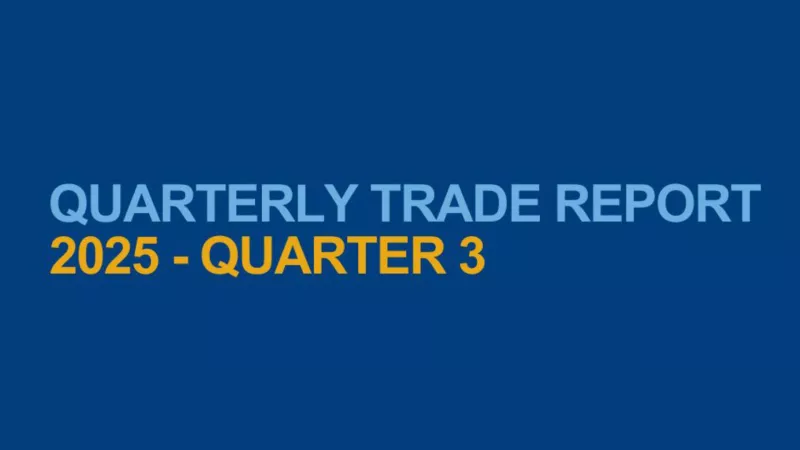
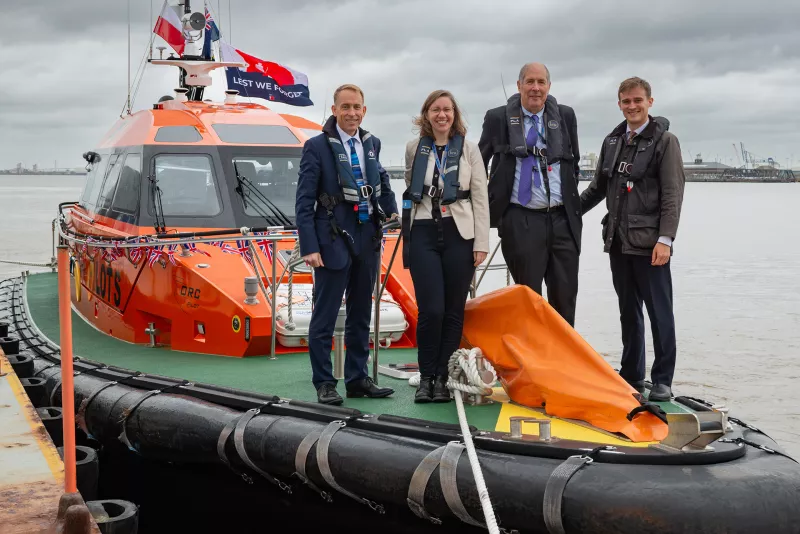
Thames 2D base model
Our state-of-the-art model can be licensed to carry out studies quickly
Case Study: C.Ro berth survey
Our in-house drone survey capacity can provide support for a variety of projects and present the data in a variety of outputs.
As part of a licensing requirement, C.Ro needed to survey the area surrounding their berth, including some shallow mud floats. The problem was that the mud flats were too shallow to survey economically with a multibeam echo sounder, due to the vey narrow tidal window when there was enough water over the area, and also that due to the shallow depths a MBES system could only survey a narrow swath.
The solution that the PLA provided was to survey the area with an aerial drone using photogrammetry. This is a technique whereby the drone takes thousands of photos as it fly a grid over the area. These photos can then be merged using specialist software to create a 3D model. We are able to generate the 3D model from the 2D photos because of the range of angles we take the photographs from. We also place control points on the land to enable the model to georeferenced.
This is an ideal solution for surveying shallow intertidal areas.
Case Study: National Grid asset inspection
High resolution photography offers unparalleled detail.
The Port of London Authority was commissioned by the National Grid Grain LNG as the principle contractor for the 2018 inspection and condition survey. the charted engineering company Marmus were subcontracted by the PLA to specify and direct inspection works.
Our high resolution photography allowed engineers unparalleled detail in reviewing hard-to-access structures. All photography is geo-tagged and mapped to fully secure google earth/GIS format -- giving engineers full high-res access for remote assessment.
High resolution panoramic photographic assets of key sections were also supplied -- enabling quick previews of potentially troublesome areas. In addition, we provided the client with 4K video to show each jetty in context.
High resolution panoramic photographic assets of key sections were also supplied -- enabling quick previews of potentially troublesome areas. In addition, we provided the client with 4K video to show each jetty in context -- above and below the waterline.
Diving works were undertaken by SeaLift and Marine plant provision, with support for all afloat operations by Whitstable Matine, both of which are experienced National Grid contractors.
A full ultrasonic thickness survey of 25% of piles both above and below the water level was undertaken and logged. The data and high resolution imagery was analysed against design and previous inspection data by Marmus to inform final asset condition reporting.
The combined data collection offers unprecedented ease of assessment for all stakeholders, from surveyor to engineer.
Case Study: Shell S-Jetty
We combined MBES, vessel-based laser and terrestrial laser to provide the client with the most detailed images of their asset.
In 2016, the Port of London Authority was commissioned by Shell to survey its S-Jetty in Coryton, Essex. The survey supported the required asset integrity assessment of the jetty and associated structures and acted as a baseline to monitor for any future changes to the structure and surrounding riverbed. Primary data was captured using the high resolution multibeam, terrestrial and vessel-based laser scanning.
Once collected we combine datasets to produce high resolution, point cloud visualisations that isolate sections of the structure for review across multiple reports. The resultant visualisations allow for any changes to be easily illustrated and reviewed in client-accessible software.
For instance, we assessed verticality and alignment of submerged piling or structures and measured deviations. By comparing with previous datasets, we can identify any significant change over the intervening period, as visualised above and below.
Using an array of techniques enables us to deliver side-by-side scan comparisons to clients, who can then decide which technique suits their needs best going forward. Furthermore, we've invested in new high-res photographic image capture.
Once images are captured, post processing enables detailed targeted imagery to be extracted -- even from areas of shade: The ultra high resolution then allows engineers to make accurate visual assessments, with all photos geo-referenced. Images can then be combined to extract a photogrammetry generated scan. The imagery data can be used to generate point clouds and associated products such as cross-sections, 3D models or drawings.
With a full spectrum of services, the PLA are able to collaborate with our clients to deliver a tailored service to the needs of each project.
Geotechnical and geophysical data
Need high resolution image of the sub-surface (<10m)?
The PLA can acquire a 3D CHIRP survey.
Benefits:
- A subsurface image with 12.5 (or 25cm) horizontal resolution
- The acquisition of GeoChirp 3D data will open opens up for extraction of geophysical properties and object detections
Deliverables:
- Report
- Geotiff of GeoChirp 3D Coverage
- Processed 3D SEG-Y files (NMO and migrated)

Need know the depth to a sub-surface layer to de-risk engineering design?
The PLA extract geophysical horizons from 2D and 3D seismic data.
Benefits:
- Allow accurate calculation of required pile depth
- Reduce the risk of surprises during the construction phase
Deliverables:
- XYZ isopach layer of the top sediment boundary
- Geotiff of GeoChirp 3D Coverage
- Processed 3D SEG-Y files
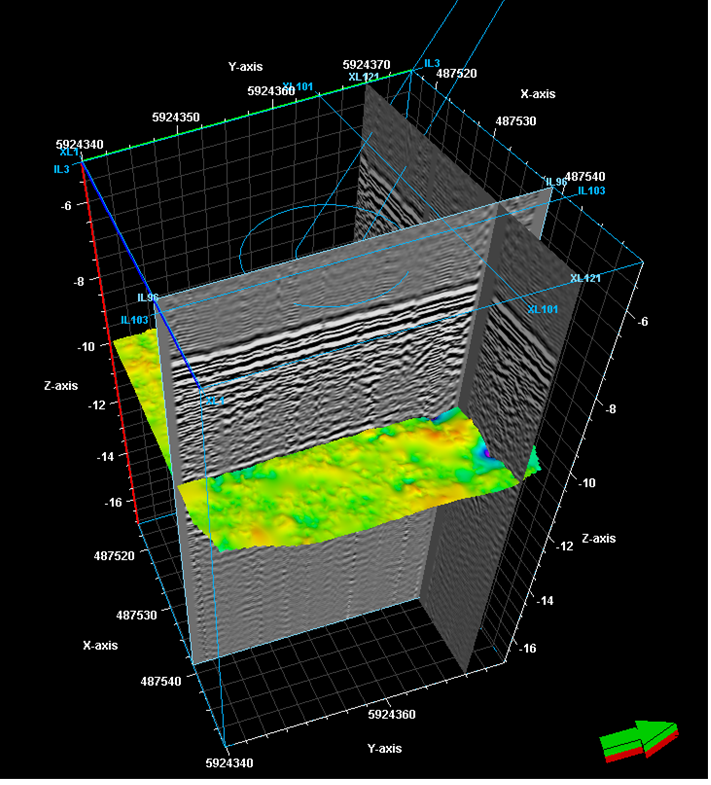
Need to know the strength of subsurface material for engineering works?
The PLA can conduct Cone Penetration Tests using a coiled tube CPT unit
Benefits:
- Deployed from vessel
- Reduced risk for engineering works
Deliverables:
- Report
- CPT data is converted in AGS format and interpreted logs produced
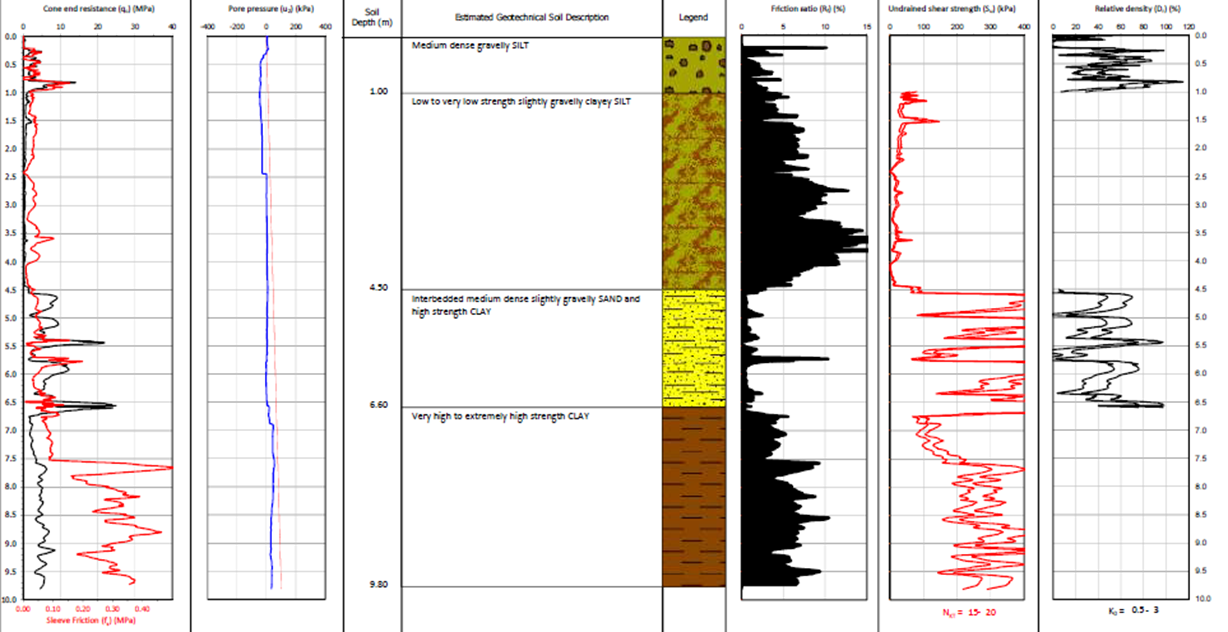
Need to obtain a subsurface core for analysis?
The PLA can acquire cores using a VibroCorer unit.
Benefits:
- Deployed from vessel
Deliverables:
- Report
- Cores
Need to image the subsurface to 10s of meters?
The PLA can acquire a 2D seismic profile using a multi-channel boomer system.
Benefits:
- 10s of meters imaged (dependant on sediments)
- True depth imaging, derivation of ground model with attenuation and velocity calculations
Deliverables:
- Report
- Processed 2D SEG-Y files (NMO and Migrated)
- True depth imaging (optional)
- Ground modelling with velocity and attenuation (optional)
Need a 2D image the subsurface to <10 meters?
The PLA can acquire a 2D seismic profile using a single channel Chirp or Pinger system.
Benefits:
- Penetration to ~10m (or approximately water depth due multiple)
- High frequency (16kHz+) giving high resolution
Deliverables:
- Report
- Processed 2D SEG-Y files
- Stratigraphic interpretation
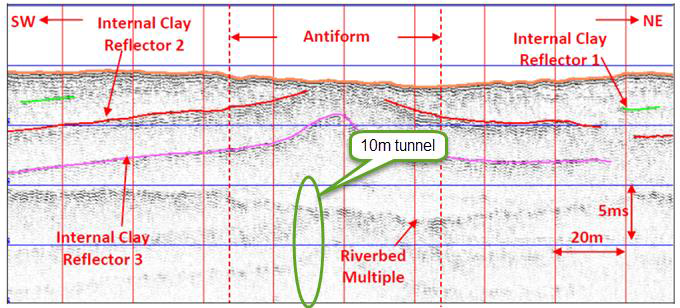
UXO survey suite
Need a UXO survey?
The PLA can acquire a suite of surveys to provide a comprehensive UXO survey package, for example:
- Gradiometer survey
- Sidescan survey
- MBES survey
- GeoChirp 3D survey
Benefits:
- Reduced risk of unexpected UXO
- Reduced risk of delays
- Valuable data set that can be leveraged for other uses
Deliverables:
- Listing of Potential Contacts, XYZ
- Target Characterisation Sheets
- Geotiff of GeoChirp 3D Coverage
- Survey report

The PLA can acquire gradiometer surveys.
Benefits:
- Identification of ferrous objects, which could affect future works
- Georeferenced
- Data can be cross correlated with other surveys
Deliverables:
- Report
- Gradiometer geotiff
- Excel list of ferrous anomalies

The PLA can acquire sidescan surveys
Benefits:
- Detects objects not readily imaged by other means
Deliverables:
- Report
- Sidescan geotiff
- Excel list of surface contacts
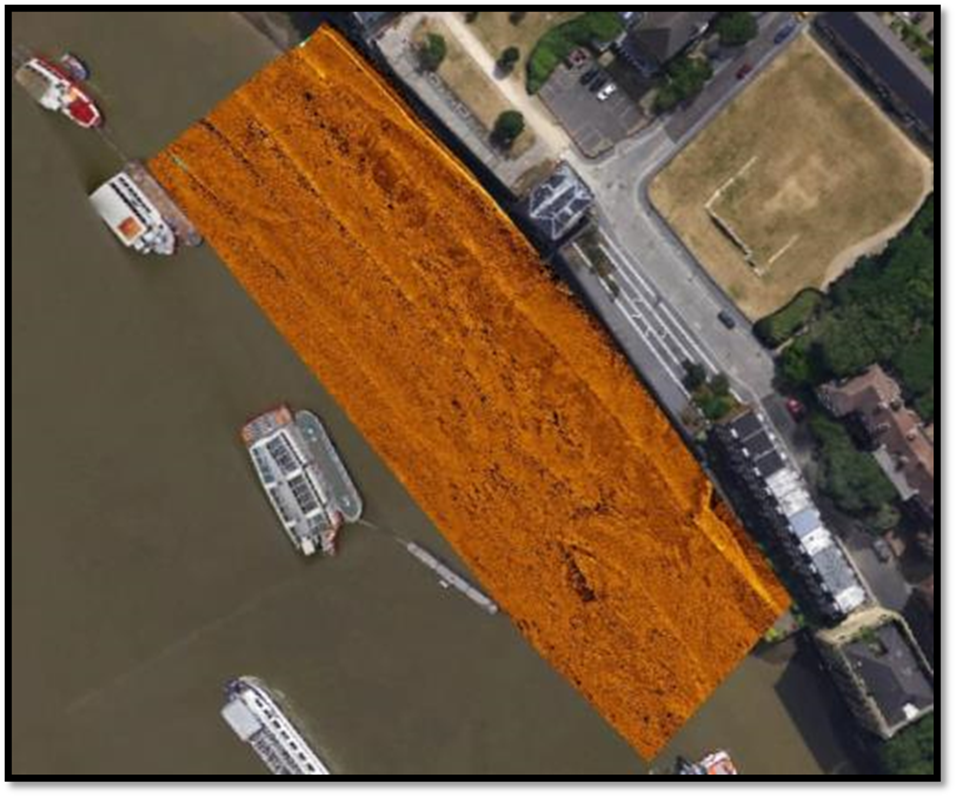
The PLA can acquire backscatter surveys.
Benefits:
- Data georeferenced, so it can be integrated with MBES data
- Can be acquired during a MBES survey
- Can be used to model surface composition, eliminating or reducing the need for grab samples
Deliverables:
- Report
- Sidescan geotiff
- Excel list of surface contacts

Need high resolution image of the sub-surface (<10m)?
The PLA can acquire a 3D CHIRP Survey.
Benefits:
- A subsurface image with 12.5 (or 25cm) horizontal resolution
- The acquisition of GeoChirp 3D data will open opens up for extraction of geophysical properties, object detections
Deliverables:
- Report
- Geotiff of GeoChirp 3D Coverage
- Processed 3D SEG-Y files (NMO and migrated)

Need to detect objects in the subsurface?
The PLA can process the GeoChirp 3D data to characterise subsurface objects.
Benefits:
- Subsurface objects accurately positioned
- Subsurface objects dimensioned
Deliverables:
- Report
- Listing of Potential Contacts, XYZ with object dimension
- Target Characterisation Sheets
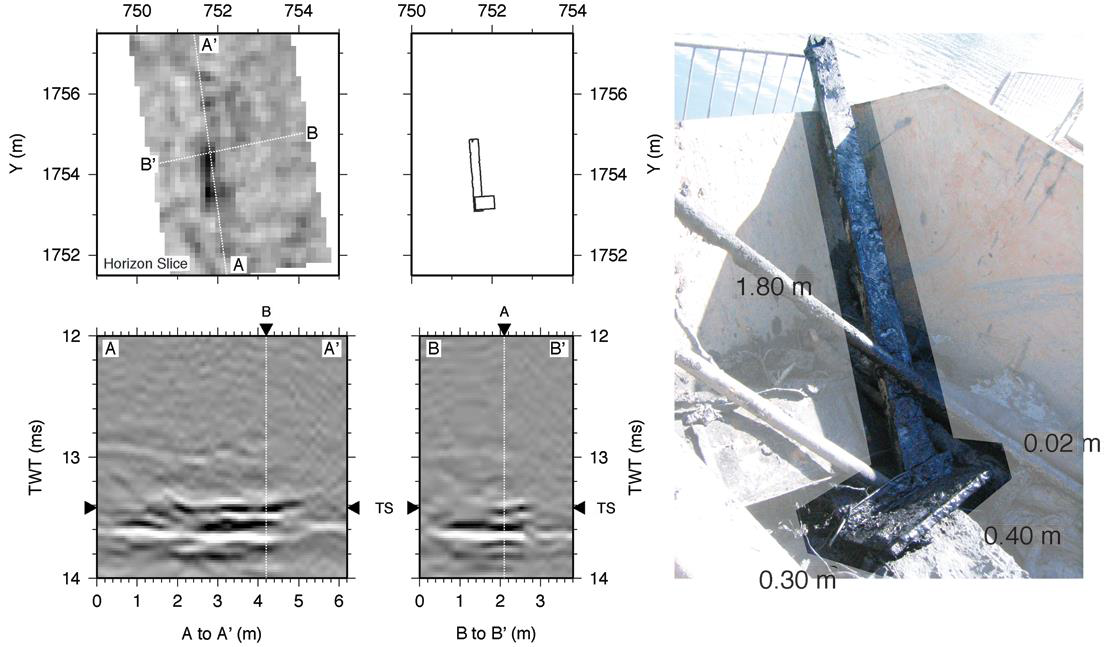
Support for civil engineering
Need support for a project?
Need a survey of under water and surface combined?
PLA can acquire both bathymetric data, surface laser data, and photographic and combine them into a single seamless point cloud.
Benefits:
- All survey data in one place
- Easy to extract measurements
Deliverables:
- full xyz point cloud
- decimated xyz point cloud
- Fledermaus scene file
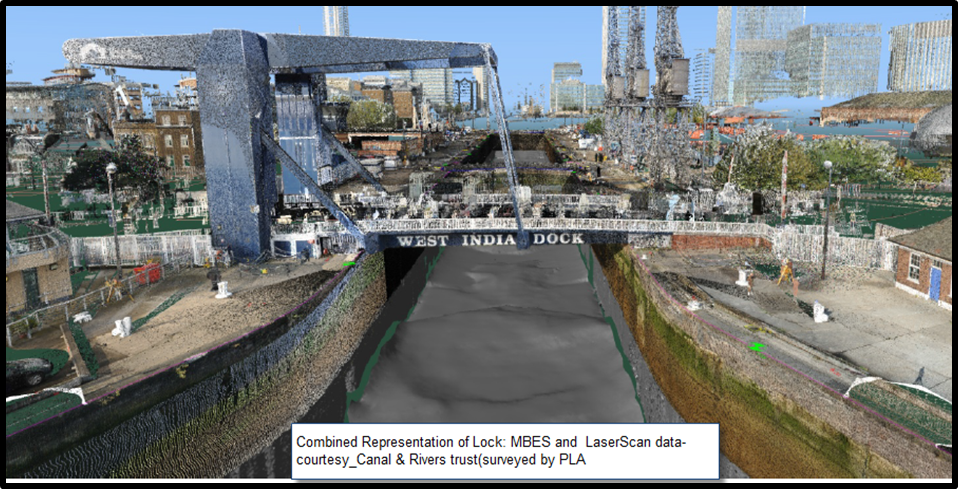
The PLA can acquire both bathymetric data of river and dock walls.
Benefits:
- Easy to take measurements from the data
- Can identify defects
- Historic record in case of any future damage
- Can reduce diver time and focus attention to defects
Deliverables:
- Full xyz point cloud
- Decimated xyz point cloud
- Fledermaus scene file
- Report

Need historic river records?
The PLA hold chart data (and other data sets) going back to early 1900s.
Benefits:
- Know the site history
- Know the changes occurring over time
- Reduce the risk of surprises during construction
Deliverables:
- PDF files
- Partially digitised-georeferenced
- Fully digitised with soundings extracted
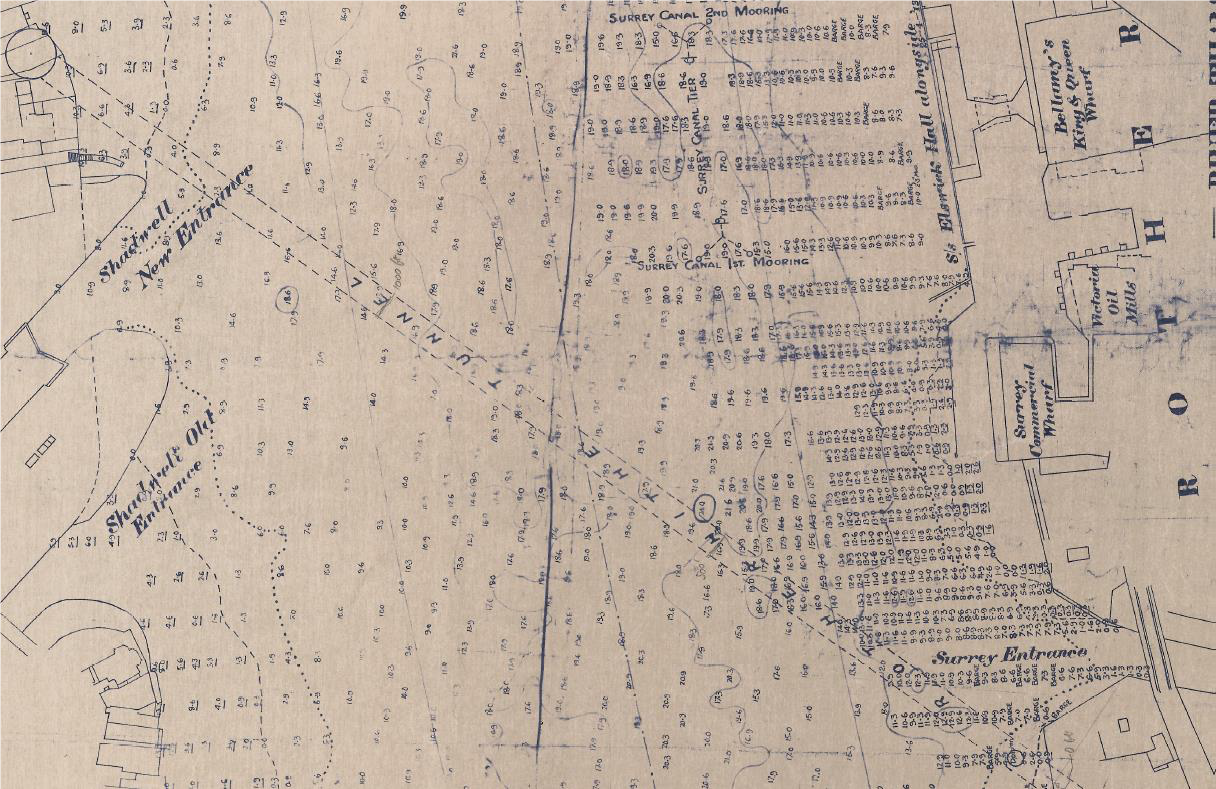
Need a UXO survey prior to works?
The PLA can acquire a suite of surveys to provide a comprehensive UXO survey package, for example:
- Gradiometer survey
- Sidescan survey
- MBES survey
- GeoChirp 3D survey
Benefits
- Reduced risk of unexpected UXO
- Reduced risk of delays
- Valuable data set that can be leveraged for other uses
Deliverables
- Listing of Potential Contacts, XYZ
- Target Characterisation Sheets
- Geotiff of GeoChirp 3D Coverage
- Survey report

Discover
